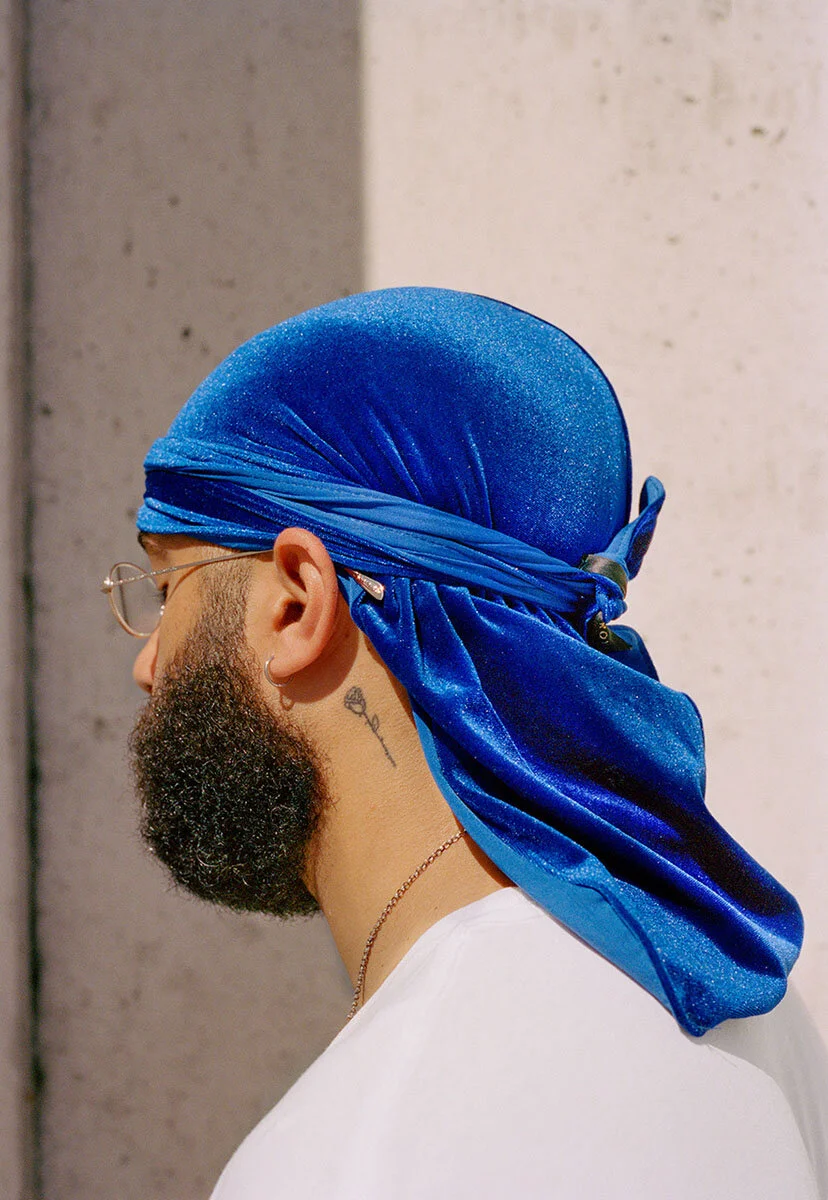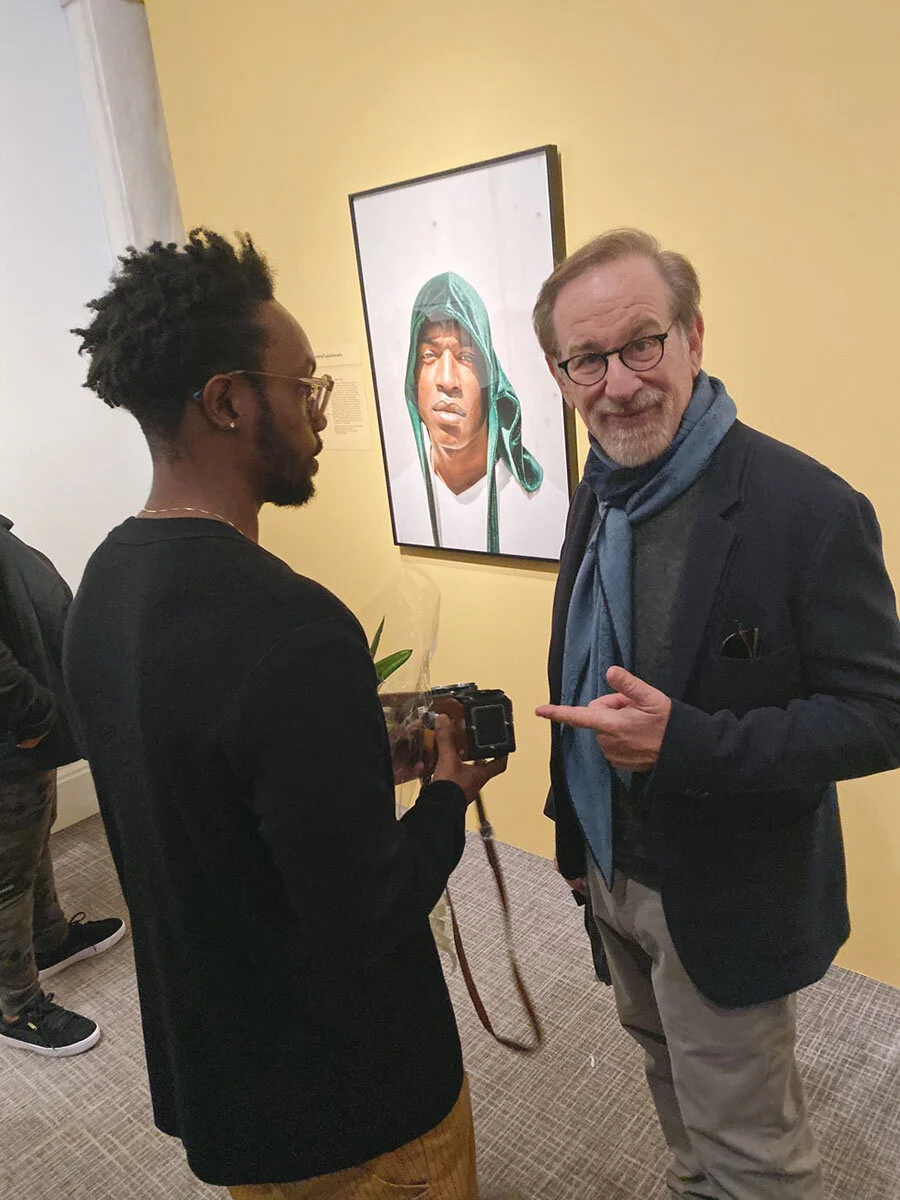Black Virgin Mary, 2018 © Adrian Octavius Walker
In 2018, photographer Adrian Octavius Walker completed We Matter, a series of portraits of Black men wearing various colors of velvet durags. The portraits are soft, stylized and empowering, breaking the stereotypes of Black masculinity often presented in popular media with bold, poppy and pastel colors.
“Black Virgin Mary,” an image from the series, was recently included in The National Portrait Gallery’s fifth triennial Outwin Boochever Portrait Competition and exhibition American Portraiture Today, on display through August 20th, 2020, among the work of more than 40 artists and photographers whose work addresses race, police brutality, immigration, and citizenship.
Photographer Quinn Russell Brown, who also has a piece in the exhibition – a portrait of Black Lives Matter activist DeRay Mckesson – speaks with the St. Louis-born, now Chicago-based artist about the higher meaning of a durag, the perspective that comes from personal experience, and the difference between photographing Black subjects and making work about Blackness.
Quinn Russell Brown in conversation with Adrian Octavius Walker
Drape, 2018 © Adrian Octavius Walker
Quinn Russell Brown: For the first few days that this show was open, in October 2019, there seemed to be a crowd of people in front of your portrait, “Black Virgin Mary.” Many of the people looking at it were African Americans in their 20s or 30s, and it was one of those moments where it seemed like people felt validated—emotionally, maybe even spiritually—by identifying with a piece of art in a major cultural institution. I’m sure you anticipated this, but what was it like when it actually happened?
Adrian Octavius Walker: To be fair, I had already seen people’s sentiments around this work because I had done other shows. But honestly, it gets elevated every time. At the National Portrait Gallery, people wanted to talk to me about how they felt. And nobody was wrong. I didn’t hear anything silly. A lot of what I heard was, “This means a lot to me.” Because they’re seeing this Black man in the Smithsonian, wearing something that they wear on their own heads.
We’ve seen this work before. John Edmonds is an amazing photographer who has done work like this. But art is a thing that repeats, and the story behind it is what makes the art—for me, at least. And this was my personal experience. The picture is great, but the message behind it carries the weight.
Black Virgin Mary, 2018 © Adrian Octavius Walker, inkjet print on display at the Smithsonian National Portrait Gallery.png
Brown: What does a durag symbolize to you?
Walker: To me, the durag is a crown. It’s protection. It’s something that we wear on our head to protect our hair. This work explores black American beauty traditions among men. The intimacy that I wanted to depict erases the possibility of threat. We are looked at as thugs because of how we wear our hair, because of what we have on our head. These things are assigned to us—we’re not asked. “He’s trouble because he had his hair tied up a certain way.” Nah, man, my hair is just wavy. It looks like the ocean. This thing on my head helps with that.
Before it became “We Matter,” it was me taking photographs for my friend’s durag line. It’s called OJI ROYALE and they’re based in LA. But when I got the photos back, I was like, “These photos are f*cking crazy. These feel very different.” I didn’t want them to just be on Instagram. So I had to break it to my friend, and they understood. I said, “I swear I’m going to hook you up with other photos, but I have to sit on these.”
I wanted to expand the notion of blackness by challenging America’s perception of black men. These photos push the viewer to see the power of kinship within the black community. So I talked to a good friend of mine, Ryanaustin Dennis. He’s a writer and curator and he interviewed me about my own work, about how these photos made me feel, and that’s where it came from.
Our Crowns, 2018 © Adrian Octavius Walker
Brown: I hesitate to say that dressing in a certain way is a political act when it’s simply the way people dress in real life. But given the politics around Black bodies and how they’re interpreted by white people and by systems of power, an outfit can be read as political in a picture. For people who might not immediately identify with “Black Virgin Mary,” what do you hope they feel when they look at it? Or is it not for them?
Walker: You hit it right on the nose. It ain’t for them, bro. My work is for those who look like me. So other people can look at it however they want. But they can’t say it’s not a good photo—that’s a fact. As far as them not understanding? Hell, I don’t understand half the work I see. But I take time to look it up and see what it’s about. A lot of people are ignorant when it comes to that. They can easily judge something by looking at it, but they aren’t going in-depth to see what it’s about.
Brown: In “Black Virgin Mary,” the man has a very chiseled and traditionally masculine face, but he also comes across as soft and beautiful. This duality is one reason the picture is so instantly compelling. Why is he referred to as the Virgin Mary, a historically female role?
Walker: When I saw this photo, I instantly thought about the Virgin Mary. The way she looks, the gaze, the softness, the headdress—all of it. I did not search for that title, it hit me in the face. It didn’t even take a second. I can’t tell you the last time I thought about the Virgin Mary, if I have ever thought about her.
The title “We Matter” is about us as Black people. I was thinking about Black men and how much we do matter, even to those who don’t think we do. I want them to know that we do. No matter how we look. We matter in all settings. If we’re in a jail cell, we still matter. We matter in a classroom. We matter all over. And we can appear in places like the National Portrait Gallery. I can tell my daughter, when she’s old enough to understand one day, that there was a Black man in a durag hanging up on those walls, two rooms from President Obama’s portrait. That sh*t crazy.
Our Culture, 2018 © Adrian Octavius Walker
Brown: That’s what I was getting at in the beginning of our conversation. The people looking at “Black Virgin Mary” in the National Portrait Gallery had the same reaction you just described.
Walker: And even with your work. DeRay (Mckesson) went through some sh*t, and he’s still going through some sh*t. His story has layers to it. He’s a brave soul. I don’t know anybody out there with the strength that he has, because there are motherf*ckers that don’t want him to exist. But he’s still present. There goes the title again: “We matter.”
DeRay Mckesson, 2018, © Quinn Russell Brown, courtesy of University of Washington
Brown: So it’s bigger than just your series. It’s a mindset.
Walker: Exactly. With your photo, if anybody comes in and looks at it in a certain way, it’s meant for them.
Brown: What do you feel inside when you see a great piece of art that features Black subject matter and was made by a Black artist? What is that viewing process like for you?
Walker: I have a friend, her name is Shani Crowe, who makes some of the most dynamic Black work that I’ve seen. I was telling my wife last night that Shani’s work inspires me so much. She does sculpture, photography, and hair-braiding. She made these basketball hoops where the net is made out of braids. Shani does art for a living, but she also gets paid for doing hair sometimes, so she uses hair as an art form. Nobody called her and said, “Can you make a basketball hoop out of hair?” That’s something that came out of her own head.
What I’m getting at is, she adapts her hair-braiding skill to every piece she does. She can adapt to anything, and still fall back onto her roots, onto what she knows: And that’s using hair. That’s braids.
Power of Kinship, 2018 © Adrian Octavius Walker
Power of Kinship performance at The Greens in Columbia, Missouri
Brown: Looking at Shani’s work and looking at your work, the art is fundamentally connected to the personal story—about what you’ve experienced. “Black Virgin Mary” is about Blackness and it is from the perspective of Blackness. My portrait of DeRay, by contrast, is a picture of a Black man, but it’s not about Blackness. As a white artist, coming from a different cultural experience, I don’t know that I could make a picture about Blackness.
Walker: It’s funny you say that. Yeah, because you ain’t Black! *Laughs* You’re not going to try to do that sh*t, either.
Brown: No, but some people do.
Walker: F*ck yeah, people do that. And it’s weird. It comes across in a really silly ass way, where somebody is trying to depict somebody else. I would never do that. That’s like going into your grandma’s house trying to tell her where her chair belongs. That’s her f*ckin’ house! That’s what I know people should stay away from: trying to explain someone else’s experience.
Side Drape, 2018 © Adrian Octavius Walker
Brown: How have people you’re close with responded to seeing your work in the National Portrait Gallery?
Walker: I’ll leave you with this quote from Holley M. Murchinson:
"It was beautiful to see a close friend’s work celebrated in a prestigious institution and it reaffirmed that we (Black people) belong in any space that we occupy (prestigious or otherwise). Adrian’s piece reminded me that art - when created with pure intention and without compromise - has the power to dismantle false narratives and create room for new truths. And that as artists, when we lean into those truths, our capacity to be catalysts for internal and external change is boundless.”
Walker with Black Virgin Mary and Steven Spielberg
—
Adrian Octavius Walker is a mixed-media artist based in Chicago, Illinois. You can see his portfolio here and follow him on Instagram.
Quinn Russell Brown is a photographer, photo editor, and writer based in Seattle. Find more of his work here or on Instagram.
“American Portraiture Today” is on exhibit at the Smithsonian National Portrait Gallery in Washington, D.C., through August, 2020. Explore the show online.










